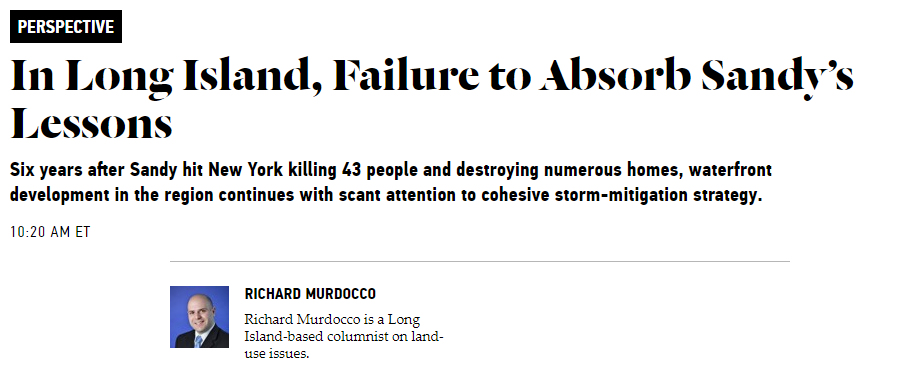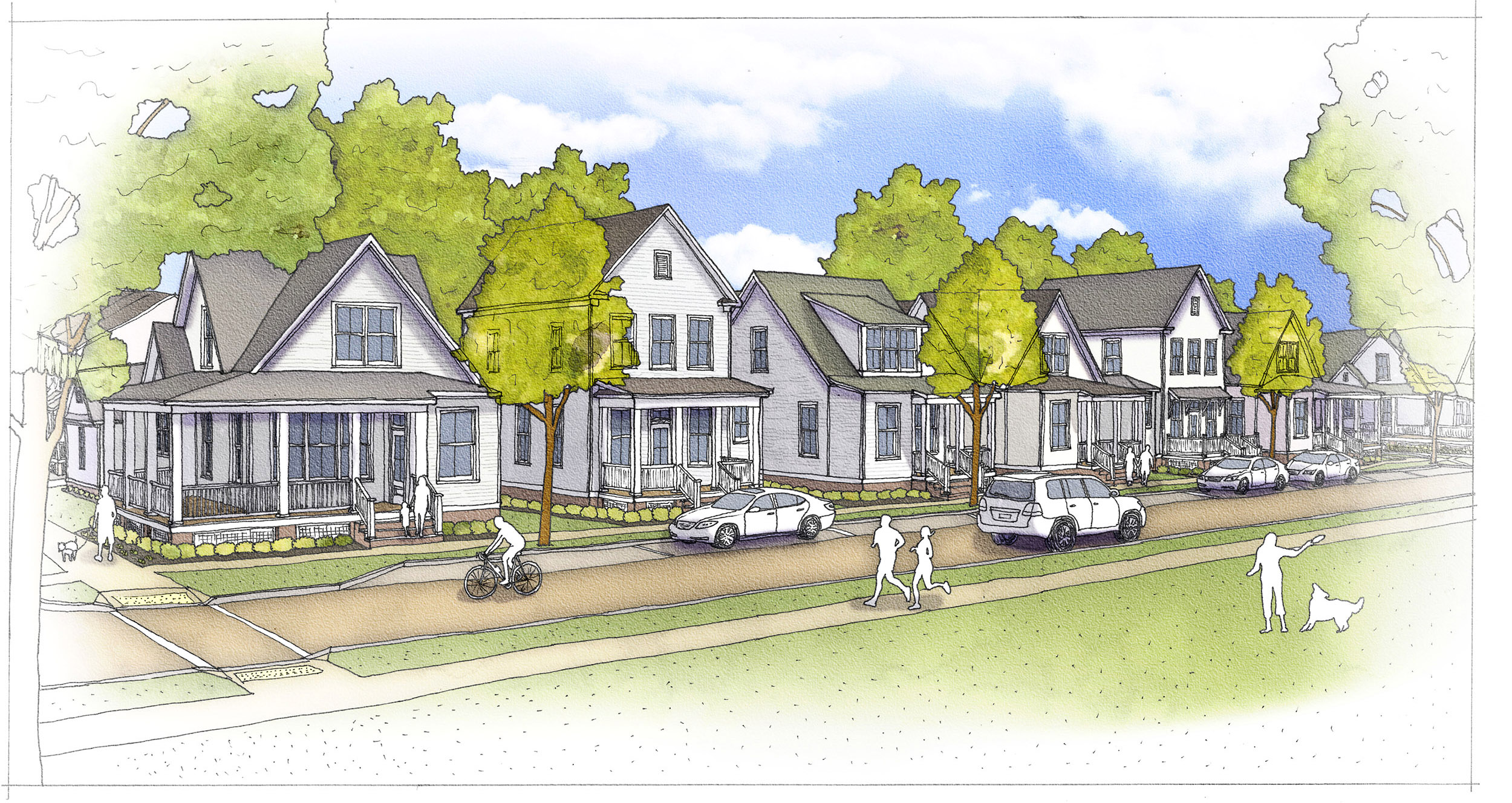The following was published by The Atlantic’s CityLab on October 22nd, 2018. You can read the original here. Want to join The Foggiest Idea’s growing team of sponsors? Click here.
By Richard Murdocco
Six years ago today [Oct. 22], Hurricane Sandy began gathering in the Caribbean Sea: Although it was classified as a post-tropical cyclone by the time it hit New York on October 29, it killed 43 people in the state, wiping out homes, and causing billions of dollars in damage. Despite repeated warnings of scientists and planners that “the next big one” is coming, the appeal of waterfront living still continues to lure buyers, investors, and builders across the New York metro region.
One of the parts of New York that was hardest hit, Long Island, is a patchwork of municipalities that control the region’s land usage with little regard given to the adoption of a collective and cohesive approach to growth. Between the filling-in of the marshes and wetlands that absorbed surge and wave action, to the construction of multi-million-dollar projects on unsteady sands, Long Islanders have long witnessed the economics of the real estate industry trump the warnings by urban planners and scientists.
Following the sobering reality of Sandy’s aftermath, developers and homeowners who build on New York’s coasts have adapted their efforts to the challenges of waterfront living. Despite the known risks, builders have not slowed their pace. The questions are: Can they build to meet buyer demand while simultaneously anticipating the storm surges and shifting sands of the future? And can local jurisdictions balance the economic pull of housing development and local preventative storm-damage mitigation with the greater good? As with all land-use issues, the answer is murky, and in the past six years, local policymakers and builders have taken a variety of different approaches:
- In Island Park, a small village tucked away on a densely-populated islet on the south shore Nassau County (one of the two counties that comprise Long Island) Sandy hit particularly hard, leading to the damage of 95 percent of the community’s housing stock. Despite the known vulnerabilities of the area, Virginia-based AvalonBay Communities purchased an 11.6–acre waterfront parcel that was formerly used as a fuel oil terminal in 2017, and is looking to build 172 rental units right on the water. On Nassau’s north shore, along the famed gold coast in Great Neck, AvalonBay built 191 apartments on the waterfront of Manhasset Bay. The developer raised both the structure and the utilities, in anticipation of future storms.
- On the former site of a marina that was destroyed by Sandy, Jericho-based developer Beechwood Homes, is elevating a new condo project in East Rockaway, a waterfront village located just north of Island Park. They are mitigating against future events by adding enlarged drainage systems that will better absorb drenching rains and flooding, and newly constructed bulkheads that will harden the coast against increased erosion. Similar to AvalonBay’s measures, the builder is placing all mechanical equipment as high as possible. A Beechwood representative said that the firm has spent roughly $5 million to protect their project from storm impacts.
Many of these measures will only be truly tested when the next powerful storm strikes the northeast. The continued push to develop the waterfront isn’t surprising, especially with ample fiscal resources available post-Sandy: Developers often receive state funds to support storm prevention measures and thus must in theory, adhere to certain standards that consider the effect on the larger region. But in some municipalities, storm mitigation and coastal zone policies are not addressed in ways that transcend political jurisdictions.
In the small village of Nissequogue on the northern shores of Long Island’s other county, Suffolk, officials are allowing property owners to fortify their shorelines against erosion, possibly at the expense of other homeowners outside of the village. “There are hardening measures such as sea walls that if done on a property-by-property basis, will have major downstream consequences that make the problem even worse,” Lawrence Swanson, an interim dean of the School of Marine and Atmospheric Sciences at Stony Brook University, told Long Island Pulse in July 2018. “If we want to maintain the Island, we can’t make one part of that complex system static,” he said.
We were warned before Sandy: In October 1984, the Long Island Regional Planning Board, a collective group of planners, economists, scientists, and the like, stated bluntly that “Long Island is highly vulnerable to the occurrence of a hurricane disaster of immense proportions,” adding that the Board had ample data in its Hurricane Damage Mitigation Plan for the South Shore to substantiate such an ominous forecast. “Coastal areas on Long Island have experienced dramatic residential and commercial development and change in recent years,” the report explained. “As a result, the Island’s South Shore is far more vulnerable to storm-related damage and potential loss of life today.” And these areas are becoming increasingly more vulnerable with accelerated climate change.
Some homeowners have opted not to rebuild after Sandy, and, thanks to New York Rising, a New York State-backed program that purchases storm-damaged properties among other planning activities, other areas will not be developed. The state spent upwards of $240 million buying flood and surge-prone parcels in an attempt to prevent future catastrophes by allowing them to return to their natural state, with the belief that the vacant lots will collectively act as a natural buffer in vulnerable areas.
So far, the majority of property acquisitions through this program have been in the areas of Staten Island hardest hit by Sandy where entire neighborhoods were wiped out by storm surge, and the program has had limited adoption in the eastern suburbs. But in Nassau County, officials have chosen not to participate in the buy-outs over fears of lost tax revenues, Rachel Wieder, who was then-director of the buyout and acquisition programs for New York Rising, said in October 2016. The choice serves as a reflection of their larger fiscal picture.
With municipalities in open competition for scarce tax revenues and a bad habit of ignoring the pleas of their neighbors under typical conditions, the x-factors that future Sandy-like storms pose add a dark ingredient to an already twisted cocktail of local governance and its politics, and things are likely to get worse.
This isn’t an issue that is exclusive to the New York area, but is currently playing out in Houston, which saw its poor land use policies face the wrath of Hurricane Harvey in 2017, and in the Carolinas, where they were battered by the slow-moving soak of Florence.
All these years later, we are being provided with increasingly vivid examples of how our land use policies on the waterfront are failing, and yet they continue to be developed, and protective policies continue to be implemented piecemeal, rather than as part of a cohesive strategy.
While memories after storm events are relatively short, the critical question still remains: Why?










Thanks very much man